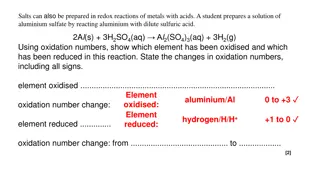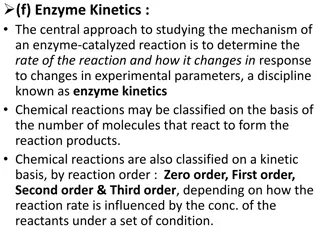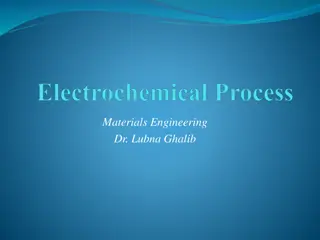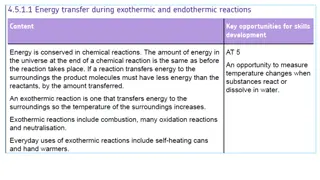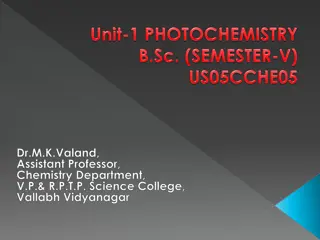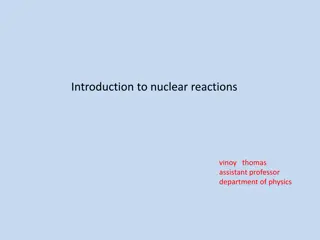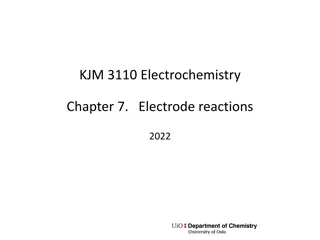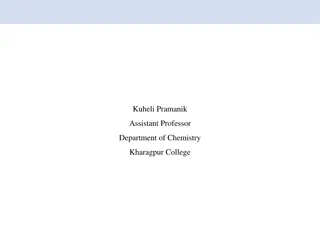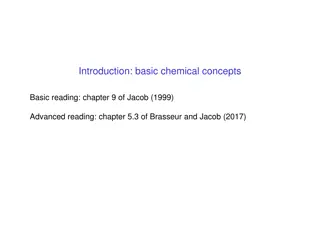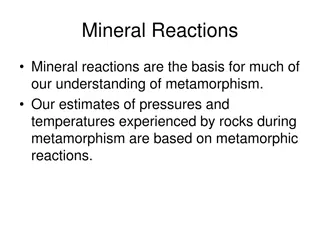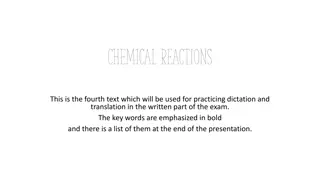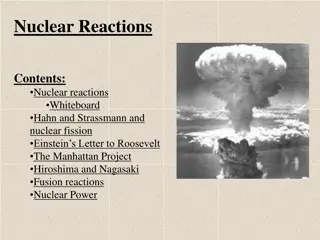Rearrangements in CBCS Semester IV System - Reactions and Mechanisms
Dr. Mumu Chakraborty, Assistant Professor at Government Girls General Degree College, presents detailed lectures on rearrangements in the CBCS Semester IV system. Topics covered include diazonium salts, electron-deficient carbon rearrangements, nitrogen and oxygen rearrangements, and aromatic rearrangements. Mechanisms and stereochemical features are discussed for various rearrangement reactions, such as Demjanov, Tiffeneau-Demjanov, and more.
Download Presentation

Please find below an Image/Link to download the presentation.
The content on the website is provided AS IS for your information and personal use only. It may not be sold, licensed, or shared on other websites without obtaining consent from the author. Download presentation by click this link. If you encounter any issues during the download, it is possible that the publisher has removed the file from their server.
E N D
Presentation Transcript
REARRANGEMENTS SEMESTER IV CBCS SYSTEM PRESENTED BY DR.MUMU CHAKRABORTY ASSISTANT PROFESSOR DEPARTMENT OF CHEMISTRY GOVERNMENT GIRLS GENERAL DEGREE COLLEGE 7, MAYUR BHANJ ROAD KOLKATA 700023, WEST BENGAL, INDIA
Diazonium salts and their related compounds: reactions (with mechanism) involving replacement of diazo group; reactions: Gomberg, Meerwein, Japp-Klingermann. Rearrangements(14 Lectures) Mechanism with evidence and stereochemical features for the following: Rearrangement to electron-deficient carbon: Wagner-Meerwein rearrangement, pinacol rearrangement, dienone-phenol; Wolff rearrangement in Arndt-Eistert synthesis, benzil benzilic acid rearrangement, Demjanov rearrangement, Tiffeneau Demjanov rearrangement. Rearrangement to electron-deficient nitrogen: rearrangements: Hofmann, Curtius, Lossen, Schmidt and Beckmann. Rearrangement to electron-deficient oxygen: Baeyer-Villiger oxidation, cumene hydroperoxide-phenol rearrangement and Dakin reaction. Aromatic rearrangements:Migration from oxygen to ring carbon: Fries rearrangement and Claisen rearrangement. Migration from nitrogen to ring carbon: Hofmann-Martius rearrangement, Sommelet Hauser rearrangement, Fischer-Hepp rearrangement, N-azo to C-azo rearrangement, Bamberger rearrangement, Orton rearrangement and benzidine rearrangement.
Rearrangement to electron-deficient carbon: 1. Demjanov rearrangement 2. Tiffeneau Demjanov rearrangement
Demjanov Rearrangement (Rearrangement to electron-deficient carbon):
Tiffanaeu Demjanov (Rearrangement to electron-deficient carbon) :
Diazonium salts and their related compounds: reactions (with mechanism) involving replacement of diazo group; reactions: Gomberg, Meerwein, Japp-Klingermann.
Migration from nitrogen to ring carbon: Hofmann-Martius rearrangement
Sommelet-Hauser Rearrangement: The Sommelet Hauser Charles rearrangement Hauser) (named after reaction M. of Sommelet certain benzyl quaternary ammonium salts.The reagent is sodium amide or another alkali metal amide and the reaction product a N,N-dialkylbenzylamine with a new alkyl group in the aromatic benzyltrimethylammonium iodide, [(C6H5CH2)N(CH3)3]I, rearranges in the presence of sodium amide to yield the o-methyl derivative of N,N-dimethylbenzylamine. and R. is a rearrangement ortho position. For example,
Mechanism: The benzylic methylene proton is acidic and deprotonation takes place to produce the benzylic ylide (1). This ylide is in equilibrium with a second ylide that is formed by deprotonation of one of the ammonium methyl groups (2). Though the second ylide is present in much smaller amounts, it undergoes a 2,3-sigmatropic rearrangement and subsequent aromatization to form the final product (3).
Fischer-Hepp Rearrangement The Fischer Hepp rearrangement is a rearrangement reaction in which an aromatic N- nitroso or nitrosamine converts to a carbon nitroso compound. This organic reaction was first described by the German chemist Otto Philipp Fischer (1852 1932 ) and Eduard Hepp (June 11, 1851 June 18, 1917) in 1886, and is of importance because para-NO secondary anilines cannot be prepared in a direct reaction. The rearrangement reaction takes place by reacting the nitrosamine precursor with hydrochloric acid. The chemical yield is generally good under these conditions, but often much poorer if a different acid is used. The exact reaction mechanism is unknown but there is evidence suggesting an intramolecular reaction.
N-azo to C-azo Rearrangement The Wallach rearrangement is an organic reaction converting an aromatic azoxy compound with sulfuric acid or other strong acids to an azo compound with one arene ring substituted by a hydroxyl group in the aromatic para position.
Bamberger Rearrangement: The Bamberger rearrangement is the chemical reaction of phenylhydroxylamines with strong aqueous acid, which will rearrange to give 4- aminophenols. It is named for the German chemist Eugen Bamberger (1857 1932). Mechanism: The mechanism of the Bamberger rearrangement proceeds from the monoprotonation of N-phenylhydroxylamine 1. N-protonation 2 is favored, but unproductive. O-protonation 3 can form the nitrenium ion 4, which can react with nucleophiles (H2O) to form the desired 4-aminophenol 5.
Orton rearrangement This reaction is the rearrangement of an N chloro acyl anilide into an N acyl p chloroanilide in the presence of an acid such as HCl and is generally known as the Orton rearrangement. This reaction proceed via a multistep processes and is promoted simultaneously by proton (i.e., H+) and chloride. It has been found that both solvent composition and substrate influence this rearrangement. In addition, the Orton rearrangement can be triggered by a Lewis acid as well as by light. Furthermore, it has been reported that the chlorination of acyl anilide from chlorine can proceed by two paths and the ortho/para ratio of isomers increase when the solvent viscosity is increased. This reaction is useful for the preparation of para halo anilides.








